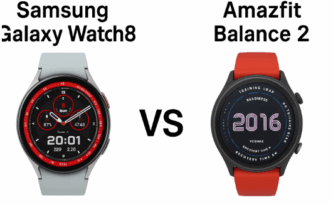
Samsung Galaxy Watch8 vs Amazfit Balance 2 Review
Smartwatches today are no longer just about telling time or buzzing with notifications. They have evolved into health companions, fitness trackers, and lifestyle tools that reflect personal choices. Samsung’s new Galaxy Watch8 enters the Indian market at ₹32,999 for the 40mm and ₹35,999 for the 44mm, bringing a refined design and smarter software. Meanwhile, the Amazfit Balance 2, priced at ₹24,999, makes a different pitch—durability, extreme endurance, and AI-powered tracking, all in a lightweight form.
I have spent time using both these watches. They do not compete in price alone but also in how they define “smart.” While Samsung leans into AI and polished software, Amazfit bets on ruggedness and long battery life. Let’s see how they compare across the key areas that matter in real-world use.
Design and Comfort
The Galaxy Watch8 wears lighter than before, with an 11% thinner cushion-shaped case. It feels sleek, premium, and closer to the Ultra line in looks. Its aluminum frame is comfortable for all-day wear, though strap swapping is a little fiddly.
The Amazfit Balance 2, on the other hand, is larger at 47mm but surprisingly light. Its sapphire glass display with a blue-tinted ring adds character. The rotating crown and knurled button feel tactile, offering easy navigation. While Samsung goes for elegance, Amazfit builds a sporty yet refined hybrid. The only drawback is the fiddly strap mechanism on both, which can be annoying during swaps.
Durability and Safety
Samsung’s Watch8 is rated 5ATM, IP68, and MIL-STD-810H. It handles sweat, dust, and pool swims comfortably. Add fall detection and SOS features, and it feels city-commuter friendly.
Amazfit Balance 2 is tougher with 10ATM resistance and military-grade build. It can take hikes, swims, and rugged adventures in stride. If you spend more time outdoors, Amazfit clearly has the edge in endurance and ruggedness.
Display and Everyday Use
Samsung has turned up the brightness this year. The Watch8 reaches 3,000 nits, making it legible under direct sunlight. Notifications, maps, and workouts all shine on its AMOLED panel. The slimmer bezels add to the premium feel.
The Balance 2 peaks at 2,000 nits. While not as bright, the sapphire crystal ensures durability and clarity. The screen is crisp enough for daily use, though Samsung’s higher brightness does make a difference outdoors.
Software and AI Experience
Here is where the two watches take different roads. Samsung’s One UI Watch 6 on Wear OS brings cleaner navigation and a useful Now Bar for quick access to ongoing tasks. Google Gemini is integrated, handling multi-step commands and quick queries. It feels smooth, modern, and genuinely helpful, though not always essential.
Amazfit runs Zepp OS, lighter and smoother. Its AI assistant, Zepp Flow, is powered by OpenAI. It handles basic tasks but struggles with real-time searches. While fluid in use, it still feels like a generation behind Samsung’s AI integration. Yet, Amazfit deserves credit for making AI accessible without heavy hardware demands.
Performance and GPS
Samsung powers the Watch8 with the Exynos W1000 (3 nm), 2 GB RAM, and 32 GB storage. App launches are instant, multitasking is seamless, and dual-band GPS improves accuracy in dense cities.
Amazfit’s Balance 2 offers 64 MB RAM with 32 GB storage. Surprisingly, it performs well with smooth animations and stable multitasking. Dual-band GPS is also included, making outdoor tracking accurate. Still, Samsung’s raw power gives it a lead in future-proofing, though Amazfit keeps up surprisingly well.
Health and Fitness Tracking
Both watches shine in this department, though in different ways.
Samsung’s Watch8 brings a running coach that assigns plans, antioxidant index testing, sleep apnea detection, and body composition tracking. It’s ambitious but sometimes too reliant on Samsung phones for advanced features like ECG and blood pressure.
Amazfit Balance 2 supports 170+ sports modes, HYROX exclusives, dual-band GPS, and detailed insights via the Zepp app. Sleep tracking is generous but consistent. The best part—no subscription wall. Data and insights are free, unlike many rivals. Amazfit wins on accessibility, while Samsung wins on variety.
Battery and Charging
This is the biggest divide. Samsung’s Watch8 lasts around two days with mixed use. It’s better than past Galaxy Watches but still behind endurance leaders. Charging takes over an hour and a half.
Amazfit Balance 2 is unmatched here. With typical use, it lasts 21 days. Even with always-on display, it stretches to 10 days. A full charge takes only an hour. For frequent travelers and those who dislike daily charging, Amazfit is the clear winner.
Verdict
Both watches serve different buyers. Samsung Galaxy Watch8 is a polished smartwatch with a bright display, refined design, and AI integration. It is for those who want a premium lifestyle watch with strong app support. But the battery still feels short, and some features remain Samsung-phone dependent.
The Amazfit Balance 2 is a hybrid that blends toughness with smart features. It cannot match Samsung’s AI depth, but it wins with its marathon battery, rugged build, and no-paywall fitness tracking. At ₹24,999, it offers serious value for those who want a dependable watch that doesn’t need nightly charging.
If you want sleek looks and advanced AI, the Galaxy Watch8 is the one. If endurance, durability, and fitness are your priorities, the Amazfit Balance 2 takes the crown.
